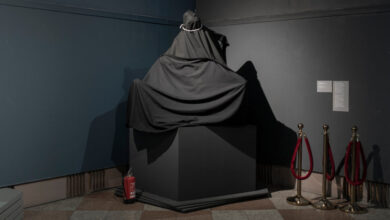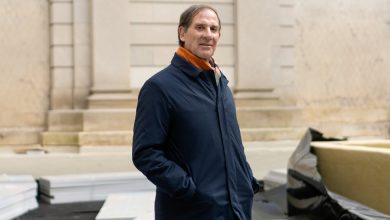The Philharmonic Plans Its Return to Geffen Hall, With Fanfare

For the past two years, the only sound coming out of David Geffen Hall, the home of the New York Philharmonic, has been the clamor of construction. That will change in October, when it reopens after a $550 million renovation.
And the Philharmonic will announce its return there with fanfare: Aaron Copland’s “Fanfare for the Common Man,” which is the first work of the orchestra’s 2022-23 season, a celebratory slate of about 150 concerts and events unveiled on Monday.
Among the season’s highlights are a monthlong festival to inaugurate the hall; a series of premieres by composers, including Julia Wolfe and Caroline Shaw; concerts exploring issues like racism and climate change; and appearances by conductors who could replace the Philharmonic’s music director, Jaap van Zweden, after he steps down in 2024.
After losing more than $27 million in anticipated ticket revenue during the pandemic lockdown, and spending much of the past year without a permanent home during the Geffen Hall renovation, the Philharmonic hopes the coming season will restore a sense of normalcy and rebuild its audience.
“It’s a moment for us not only to reunite with people who have come before, but as we look to the future, to develop and nurture new audiences,” Deborah Borda, the Philharmonic’s president and chief executive, said in an interview. “We can’t just expect people to come. We have to invite them.”
The Philharmonic recently announced that the renovation is fully funded and on track to finish in October, a year and a half ahead of schedule, after construction was accelerated during the pandemic. The new space will bring both aesthetic and acoustic improvements, with wavy beech wood walls and vineyard-style seats that wrap around the stage.
There will also be additions meant to draw people in, including a 50-foot digital screen in the lobby that can broadcast concerts to the public, and a studio looking out onto Broadway. The goal, Borda said, is for the hall to be a “home for music and a home for New Yorkers.”
The season begins Oct. 7 with a program called “Thank You Concert,” led by van Zweden, for an audience of emergency medical workers and construction workers who took part in the hall’s renovation. Two galas, and an open house weekend, will follow later that month.
Opening festivities include the world premiere, performed at two free concerts, of “San Juan Hill,” a work by the trumpeter Etienne Charles, who is known for blending jazz with the music of his native Trinidad. Several other contemporary works will be featured, including the American premiere of a piece by Shaw; and the world premiere of “Oyá,” a work for light, electronics and orchestra by the Brazilian composer Marcos Balter.
Some of the new works were written specifically for the renovated hall. “The early weeks are designed to be an exploration,” Borda said.
As the Philharmonic continues its search for a new music director, guest conductors will get more attention than usual.
Several familiar names will take the podium, including Gustavo Dudamel, the music and artistic director of the Los Angeles Philharmonic, who will lead Mahler’s Ninth Symphony in May. In March, another prominent contender, Susanna Mälkki, the outgoing chief conductor of the Helsinki Philharmonic Orchestra, will conduct the New York premiere of a double concerto by Felipe Lara, featuring the flutist Claire Chase and the bassist Esperanza Spalding, in their Philharmonic debuts.
Santtu-Matias Rouvali, the Philharmonia Orchestra’s young principal conductor, is the only guest who will get two weeks of concerts, leading the New York premiere of Magnus Lindberg’s Piano Concerto No. 3, featuring Yuja Wang, in January. The following week, he will shepherd the American premiere of Anna Thorvaldsdottir’s “Catamorphosis,” in a program that also includes Stravinsky’s “The Rite of Spring.”
Given the dearth of female conductors among the largest American orchestras, some have argued that the Philharmonic should choose a woman as its next music director. Several rising conductors, many of them women, will make their debuts with the ensemble next season, including Karina Canellakis, the chief conductor of Netherlands Radio Philharmonic Orchestra; Ruth Reinhardt, a former assistant conductor of the Dallas Symphony; and Nathalie Stutzmann, who takes the podium of the Atlanta Symphony Orchestra next season.
Borda declined to comment on the music director search, except to say that the upcoming season was “obviously an opportunity to see some returning talent and some wonderful new talent as well.”
Soloists appearing for the first time with the orchestra include the Icelandic pianist Vikingur Olafsson, who will play Ravel’s piano concerto in November, and Cynthia Millar, playing the ondes Martenot, an early electronic instrument, in Messiaen’s “Turangalîla-Sinfonie,” alongside the pianist Jean-Yves Thibaudet, in March.
The season includes concert series designed to address modern issues, including “Liberation,” about social injustice; “Spirit,” about “humanity’s place in the cosmos”; and “Earth,” about the climate crisis.
As part of “Liberation” in March, the Philharmonic will premiere a work by Courtney Bryan and Tazewell Thompson. “Spirit,” that same month, will include Bach’s “St. Matthew Passion,” which the Philharmonic has not performed since 2008.
“Earth” will close out the season in June, with the world premiere of Wolfe’s “unEarth,” a multimedia oratorio that explores forced migration, loss of nature and adaptation. John Luther Adams’s “Become Desert,” the sequel to his Pulitzer Prize-winning “Become Ocean,” will get its New York premiere.
Borda said that throughout the new season, the Philharmonic wants people to feel that “their lives have been touched and changed.”
“If we accomplish that,” she added, “we could all be very proud.”





